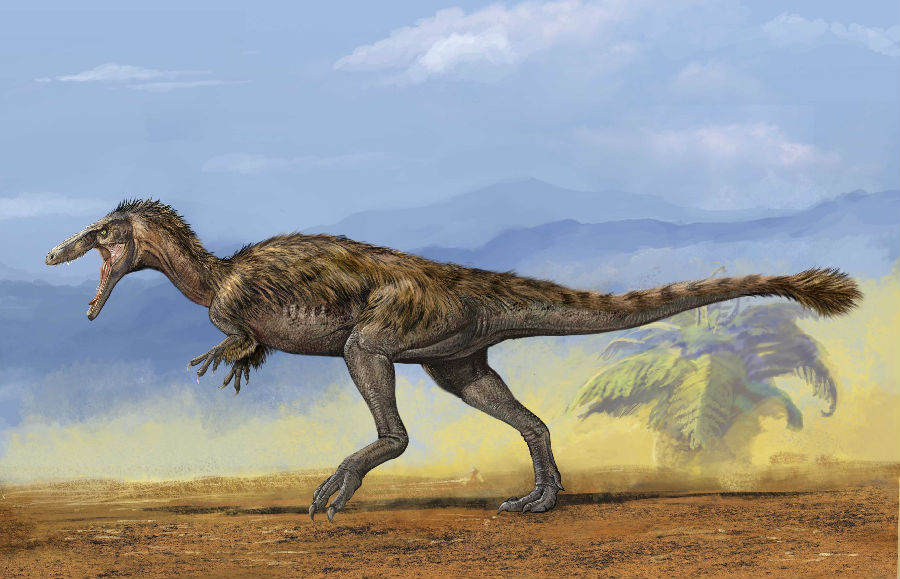(单词翻译:单击)
Gastonia lowers his body to protect his underside.
加斯顿龙伏低身体保护身下。
His tail is heavily armored, but its powerful muscles are able to move it with surprising speed.
它的尾巴全副武装,但其有力的肌肉能带动尾巴以惊人的速度移动。
This is its only chance.
这是它唯一的机会。
The Utahraptor has moved into the perfect position for the Gastonia.
犹他盗龙来到了对加斯顿龙来说完美的位置。

The moment that raptor takes one more step back, he'll be able to deploy his anti-raptor scissors.
只要这头迅猛龙再往后撤一步,它就能动用它的反迅猛龙巨剪。
Gastonia's brain is slow, but its reflexes are quick.
加斯顿龙的头脑很慢,但是反射动作很快。
The tail of the Gastonia is slung forward and these giant scissors come together and slice through the meat of the leg of this massive Utahraptor.
加斯顿龙的尾巴向前掷过去,这些巨大的剪刀合到一处,切过庞大的犹他盗龙腿上的血肉。
The shearing action moves one blade over the other.
剪切动作让一个甲片从另一个上面错过。
The Utahraptor tries to regain his footing, but the little Gastonia isn't done.
犹他盗龙试图重新站稳,不过小加斯顿龙还有后招。
He swings his tail from side to side like some medieval chainsaw, these sharp spikes slice through the soft skin of the Utahraptor.
它向两侧摆动尾巴如同中世纪的链锯,这些锋利的尖刺切过犹他盗龙柔软的皮肤。
He rolls to get away from this deadly attack.
它滚向一边躲开这致命的袭击。
The Gastonia has won the battle.
加斯顿龙赢得了战争。
Once Gastonia believes that the Utahraptor is unable to continue the attack, he returns to the business at hand - searching for water.
当加斯顿龙确定犹他盗龙不能再继续进攻后,它就回去继续手头的工作——寻找水源。
The brain of a dinosaur is like a series of light switches, one is on and everything else is off.
恐龙的大脑就像一系列电灯开关,一个打开了其它的便都关上。
They think about hunting, survival, reproduction, food.
它们考虑狩猎、生存繁殖和食物。
The moment the little Gastonia no longer sees the Utahraptor as a threat he completely disregards him and goes back to his search for water.
小加斯顿龙不再把犹他盗龙看做是威胁的那一刻,它完全忽略它转而回去寻找水。
But the evidence found near Moab, Utah gives us one last clue to what happened.
然而在犹他州摩押镇找到的证据,关于发什么了什么给了我们一个最后的线索。
Despite the carnage, both Utahraptor and Gastonia managed to survive this battle.
尽管都受了伤,犹他盗龙和加斯顿龙在战斗之后都活了下来。
Probably, both dinosaurs were ultimately killed by drought.
有可能,两头恐龙最终都因干旱而丧命。
The fact that neither dinosaur had wounds on the bodies and that the bodies were relatively intact suggests that these dinosaurs didn't die in battle, they died because of environmental conditions, like a drought.
两头恐龙身体骨架上都没有伤痕而且都相对比较完整,说明它们没在战争中死去,它们的死于是环境条件,比如干旱。
These individual dinosaurs lost their lives to a seasonal drought.
这两头恐龙因为季节性干旱而丢了性命。
But early in the Cretaceous period, both species would eventually lose the bigger fight, becoming extinct.
不过在早白垩纪时期,两个物种都逐渐在另一场更大的斗争中败下阵来,它们都灭绝了。
Why Utahraptor and Gastonia didn't go beyond the early Cretaceous is very difficult to say other than to speculate that it was like modern extinctions due to environmental factors, changes in patterns of food due to climate and things of this nature.
为什么犹他盗龙和加斯顿龙活过早白垩纪时期,这很难说,只能推测这是像现代灭绝现象一样由环境因素造成的,气候和其它自然变化导致食物模式的改变。
Larger herbivores were moving in and taking advantage of the foliage that little Gastonia couldn't have reached.
更大的植食动物出现并且进食小加斯顿龙够不着的绿叶。
Larger herbivores meant larger predators came in and even though Utahraptor is an incredibly dangerous dinosaur, he simply got out competed by a bigger more vicious kind of predator.
更大的植食动物带来更大的掠食者,尽管犹他盗龙已经是相当危险的恐龙,它却败给了一种更大更凶残的掠食者。
120 million years ago, dinosaurs were the planet's dominant species, but when conditions changed, their size and power couldn't help them.
一亿两千万年前,恐龙是地球的主宰性物种,不过当条件改变时,它们的体型和力量也帮不了它们。
Too large and inflexible to adapt, they left only fossils to tell their story.
太过庞大且不灵活而不能适应(环境的改变),它们只留下化石来讲述它们的故事。


